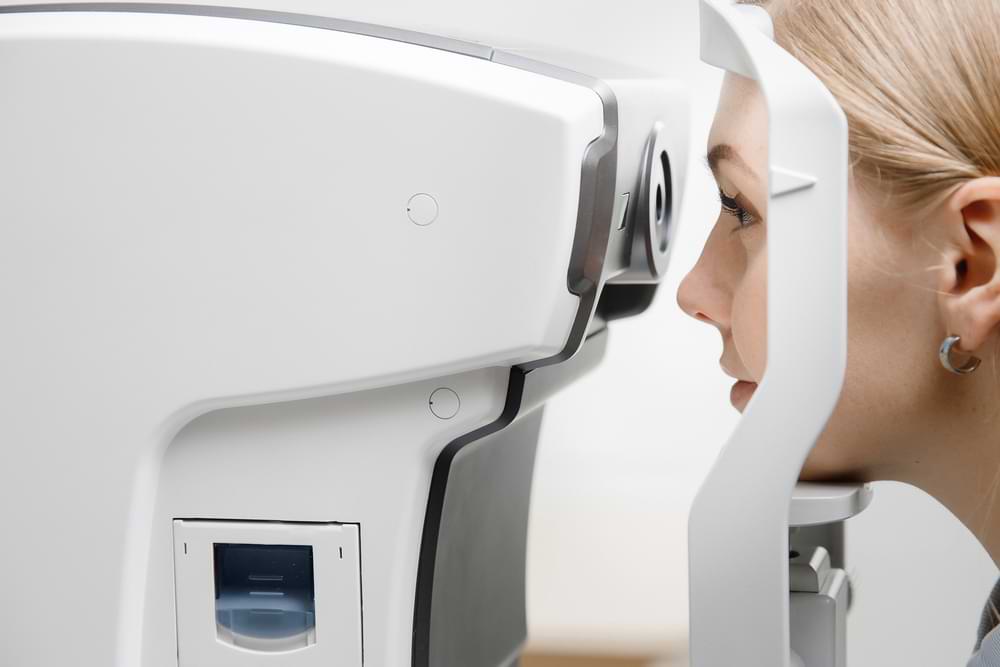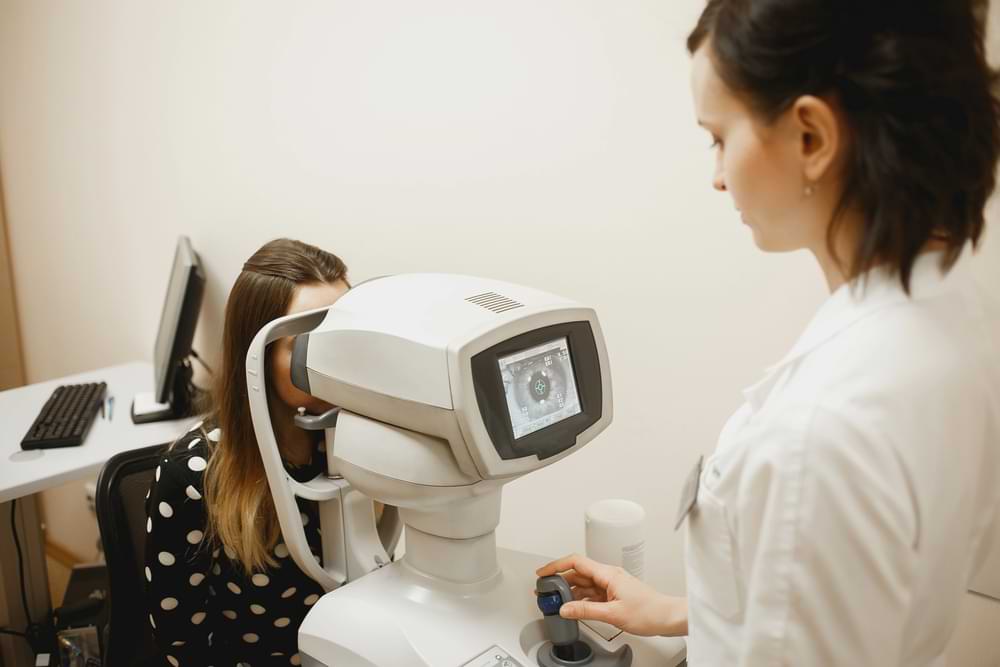Why Get An OCT Eye Scan in Melbourne?

Noticing subtle changes in your vision, but not regular eye tests say nothing is wrong? Why not ask your doctor for an OCT scan? Optical Coherence Tomography (OCT) is one of the most precise ways eye specialists can assess your eye health. Unlike a regular retinal image, it gives your eye doctor a 3D look beneath the surface.
I’m Minh Van Tran, Principal Optometrist at VisionPro Optometrists. In this article, I’ll explain how an OCT eye scan in our Melbourne clinics might give you more clarity regarding your eye health and how my team can help.
Key Takeaways
- OCT scans retinal layers beneath the surface for early disease detection
- Detects glaucoma, macular changes, and diabetic damage before symptoms show
- Quick, painless, and contact-free eye scan using light, not radiation
- Tracks changes over time, even if your vision feels normal
- Works best with other tests for a full picture of eye health
What Is an OCT Eye Scan?
An OCT eye scan is an advanced imaging technique that lets us examine the back of your eye in fine detail, layer by layer.
Many call OCT eye scans a bit like a “light” version of an ultrasound. This is because it uses harmless light waves, not radiation or dye, to build a high-resolution, cross-sectional map of the retina and optic nerve. This lets us detect early structural changes that regular eye tests or simple retinal photos can miss.
Do OCT eye scans take long? Not at all. The scan takes just a few seconds, requires no physical contact, and is completely painless.
OCT eye scans help us see beneath the surface of your retina, revealing subtle changes associated with conditions like macular degeneration, glaucoma, and diabetic retinopathy, often before symptoms appear.
Why Get an OCT Eye Scan in Melbourne?
OCT imaging helps identify early changes in the eye that could signal conditions like:
- Macular degeneration: OCT reveals thinning or fluid build-up in your macula before vision declines, allowing timely steps to manage age-related vision loss.
- Diabetic retinopathy: It can detect tiny blood vessel leaks or swelling caused by diabetes before you notice any changes in your day-to-day sight.
- Glaucoma: OCT tracks optic nerve fibre loss even when pressure levels seem normal, offering earlier insights than a standard eye pressure test.
These conditions may not cause symptoms in their early stages, so the sooner we can track any structural change, the sooner we can guide your management options.
Non-Invasive and Comfortable
As mentioned, OCT is painless, contact-free, and usually takes only a few seconds. Many Melbourne clinics, including ours, include it as part of a more detailed diagnostic eye check.
What to Expect During the Test
What would the actual process be like when you take an OCT eye scan in our Melbourne practices? You’ll be seated and asked to look at a visual target. The machine does the rest; capturing multiple images within seconds. No drops are required unless further pupil dilation is needed.
Results are available immediately. You can usually drive right after unless dilation drops were used, which can blur your vision temporarily.
Who Should Have an OCT Eye Scan?
Not sure if an OCT scan fits your profile? You should have an OCT eye scan if you relate to the following criteria:
- Adults over 40: Age increases the risk of retinal and optic nerve changes, making regular OCT scans important for proactive monitoring and early detection.
- People with a family history of glaucoma or macular conditions: OCT allows us to spot inherited patterns or structural risks earlier, often before traditional symptoms or vision loss appear.
- Diabetics requiring regular retinopathy screening: Even well-controlled diabetes can silently affect the retina; OCT shows fluid, swelling, or damage before it affects your vision.
An OCT scan helps document baseline eye health measurements. We use these to compare changes year-on-year. Athletes or individuals with demanding visual tasks may also benefit.
Differences Between OCT and Other Eye Tests
| Feature | OCT (Optical Coherence Tomography) | Standard Retinal Scan |
| Imaging Depth | Views cross-sectional layers beneath the retinal surface | Shows the surface of the retina only |
| Detail Level | High-resolution imaging of macula, optic nerve, and retinal layers | General overview of the retina’s surface |
| Use Case | Detects early signs of glaucoma, macular degeneration, diabetic retinopathy | Useful for documenting obvious visible changes |
| Floaters Detection | Cannot directly visualise floaters but helps rule out related retinal damage | May not detect floaters or internal retinal changes |
| Clinical Role | Best used as part of a full eye health check with other diagnostic tools | Often used as a standalone screening method |
The key difference between OCT and other eye tests lies in the level of detail.
A standard retinal scan is like a surface photo of your eye as it captures what’s visible on the outside. OCT goes deeper. It’s more like a cross-sectional diagram, showing the internal layers of your retina, including the macula and optic nerve.
This distinction is important because many serious conditions (glaucoma, macular degeneration, or diabetic swelling) start beneath the surface.
- In early glaucoma, the optic nerve may thin gradually. OCT can spot this before noticeable damage occurs.
- In diabetic retinopathy, it may reveal fluid or swelling in the retina that isn’t yet causing blurred vision.
While it’s true that the OCT is a lot more detailed compared to other eye tests, it can’t show floaters directly, as they are found in front of the retina. However, getting an OCT test can rule out associated damage.
That’s why we often combine OCT with other tests. Together, they give a clearer picture of your overall eye health and help us track any subtle changes over time.
Understanding Costs and Medicare
Depending on the clinic, OCT scans typically cost $50 to $120. Some optometry practices include them as part of a comprehensive check-up.
Medicare only covers OCT in limited cases, such as the first scan when a new diagnosis of wet macular degeneration is made by an ophthalmologist. For most routine use, it’s not covered. Some private health funds may rebate part of the cost depending on your extras.
Always check with your optometrist or provider before your visit to confirm if any rebates apply.
Why Choose VisionPro Optometrists?
At VisionPro, we make advanced eye health checks more accessible through:
- Detailed OCT imaging for macular degeneration, glaucoma, and diabetic retinopathy
- Comprehensive eye exams with same-day scan review and clear explanations
- Therapeutic care options, including tailored management plans and medical referrals
- Convenient locations in Footscray and St Albans with bilingual staff in English and Vietnamese
- Baseline tracking for patients over 40 or with family history of eye disease
If you’re after more than a routine test, our clinics combine experience, clear communication, and precise diagnostic tools to support your long-term vision.
Final Thoughts
OCT scans are a valuable diagnostic tool, especially if you’re looking for more than a basic vision check. This type of comprehensive scan provides insight into the internal health of your eyes, helping track changes over time and guide early action.
If you live in Melbourne and want a more complete picture of your eye health, visit us at VisionPro Optometrists in Footscray or St Albans. Our team can help you understand if OCT is right for you and when it should be part of your regular check-up.
You can call us on (03) 9687 8787 for Footscray, (03) 9364 5509 for St Albans, (03) 9600 1142 for Sunshine OR arrange an appointment using the “Book An Appointment” button in the navigation menu. All our practices are easily accessible, with nearby parking and public transport options available.

Minh gained his Bachelor of Optometry in 2000, and his Certificate in Ocular Therapeutics (ACO) in 2016.
He started VisionPro Optometrists in 2008 and has been Principal Optometrist ever since, working in both the Footscray and the St Albans practices.
Minh is a member of Optometrist Association Australia and the ACO. He always strives to achieve the highest standard of professionalism when delivering eyecare to all his patients.
Minh’s special areas of interest include ocular diseases and management, children’s vision and contact lens fitting. Minh enjoys travelling and reading in his spare time.

